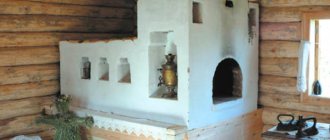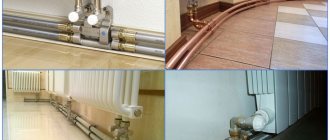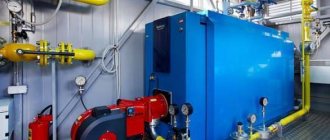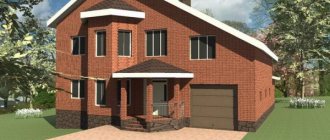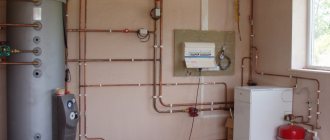Set of socks, Omsa socks
349 ₽ More details
Set of socks, Omsa socks
349 ₽ More details
Keys for 6
Living outside the city, people invariably face the need to equip an optimal heating system, which guarantees comfort and coziness in a private home. The technologies used today can solve heat problems and reduce the homeowner's utility costs. It will be necessary to decide which heating is best for a private home, install it correctly and subsequently use the equipment correctly.
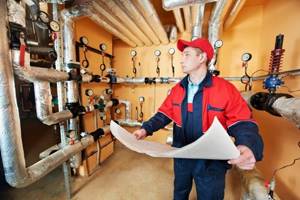
In a private house, you need to think through all the little details, including what kind of heating there will be
Which heating system to choose
A fireplace or stove can handle heating a small country house, but for a cottage such a solution is unacceptable. It's nice to spend an evening by the fireplace, but lighting wood in all rooms every day is tiring and irrational. The power source for the heating system in a private home should be the most affordable type of fuel, especially if you are planning to do it yourself:
- Electricity.
- Coal.
- Briquettes of peat and shavings.
- Firewood.
- Liquid fuel (diesel fuel, fuel oil, diesel fuel).
- Gas.
Budget heating options
In rural areas and remote regions, heating systems of private houses are installed taking into account complicating factors:
- during power outages, any innovations and technological solutions turn into a pile of useless rubbish; after the lights are turned off, the rooms cool down;
- it is often necessary to consider heating options without gas, since connecting to the main line is too expensive or technically impossible;
- the price of liquefied gas and related equipment does not allow an owner with low income to arrange autonomous heating;
- limited budget.
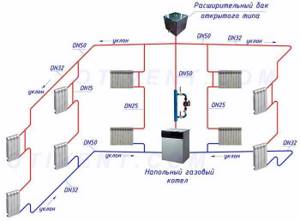
In such conditions, a non-volatile heating scheme, implemented in 2 ways, is considered modern:
- Gravity distribution from pipes of increased diameter is installed, observing slopes in horizontal sections, as was done above in the diagram of a two-story house. The coolant is heated by a stove with a water circuit or a boiler that does not require electricity.
- A brick oven is being built with access to 3-4 rooms. In a small country house there is a metal or cast iron wood-burning stove.
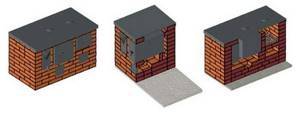
The heat source can be a floor-standing gas boiler with non-volatile automation such as “Zhitomir”, “Lemax”, AOGV and the like. If there is no gas on the site, you can install a direct combustion solid fuel heat generator controlled by a chain draft regulator.
During the Soviet era, when populated areas were massively supplied with gas, the owners of residential buildings destroyed brick stoves, which wasted space. Now there is a reverse trend - stoves are being restored or built from scratch.
Many modern developers prefer to include a high-quality brick heater into the project and not depend on external factors. If the old stove in the house is still there, restore it, as shown in the video:
Water heating
This is the most common system in which water or other non-freezing liquid circulates through pipes. The type of boiler depends on what fuel you have. The system consists of a boiler and a closed loop of pipes connected to the premises. Heating of the rooms is provided by radiators, the cooled water flows back into the boiler.
pros
- Coolant availability.
- Constant volume of water in the system.
- Easy to install.
- Uniform heating of all rooms along the circuit.
Minuses
- Caring for radiators, the heat transfer of which decreases when dirty.
- Slow heating of rooms.
- Possibility of pipe leakage due to corrosion.
- Requirements for the purity of water in the system.
- The system must constantly work in cold weather, otherwise the water may freeze and the pipes will burst.
Scheme
The do-it-yourself water heating scheme for a private house looks like this:
Water heating with a gas boiler is a proven traditional system. Most private houses are heated in this way. For a house in which you live permanently, this system is suitable, but for heating a summer house it is too expensive.
Water heated floors
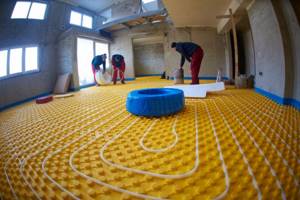
Water floors guarantee a comfortable stay in the room. A water heated floor is a rather complicated design, but it is cost-effective due to its convenience and coziness. Installation of such a structure costs a pretty penny, but is popular due to its low operating costs. Pipes are laid under the flooring, and heated water circulates through them. A pump is required for proper circulation. The heating option is very suitable for large country houses that do not have central heating connected. In this situation, purchasing and installing a water floor will be cheaper than purchasing and installing an electric heating system (due to electricity prices).
Air heating
The house is heated with hot air, which can be heated by steam, hot water, heat from combustion of fuel, or electricity. In the system, warm air from the air heater enters the premises through an air duct.
Heaters for air heating are presented on the Russian market:
- Fan coil units operating using hot water. Almost all of the presented installations of American, European or Asian production are intended for office buildings, although you can also find units for private homes.
- Gas air heaters.
- Heaters running on diesel or solid fuel.
- Airhandler electric heaters are installed in air conditioners with a fan. Typically electric heaters work with a heat pump.
pros
- Problems with the coolant are excluded, that is, the system cannot leak or freeze.
- Possible associated humidification of indoor air.
- Air conditioning and ventilation in the house.
- The efficiency reaches 90%.
- Rapid heating of the air.
Minuses
- High price.
- A fairly large area is required to install the generator.
- Relatively low heat transfer.
Private houses are heated with air only in 30% of cases, which is mainly explained by the high cost of installation and maintenance. For a country house, do-it-yourself air heating can be very convenient, provided there is an uninterrupted power supply.
Which scheme is best to choose?
The variety of home heating schemes raises a reasonable question for the home owner about choosing the most efficient heating system for his home. Currently, single-pipe and gravity-flow systems are practically not used. Typically, these schemes are recommended for areas with unstable electricity supply.
In modern cities, urban-type settlements and even in rural areas, there are no longer any problems with energy resources. Therefore, gravity systems are used only in places remote from civilization, for example, far-flung summer cottages.
For private houses where it is planned to heat the premises with heating radiators, the best results are shown by a two-pipe or radial heating network arrangement. Although both options differ in the piping layout, they are united by the ability to disconnect and replace a leaking radiator without turning off the main heating.
How to calculate the required parameters?
Do-it-yourself home heating is available to any home craftsman, but to do this, you must first calculate the basic parameters of the heating system. For a simplified calculation, you can use the universal formula:
| 1 kW of power = 10 m2 of heating power |
To more accurately determine the required design parameters, it is necessary to apply correction factors that take into account the structural features of a residential building.
For example, if the house was built several decades ago, the exterior walls are insulated, and the wooden windows are replaced with modern sealed window units, an adjustment factor of 1.5 is applied. When calculating the thermal parameters of a house built relatively recently, but without insulated external walls and with leaky wooden windows, it is necessary to double the calculated power.
The amount of thermal energy in a residential building depends on the number of window openings and their orientation to the cardinal points:
- Coefficient 1.3 is used to determine the need for thermal power in the rooms of a residential building with two windows facing north.
- Coefficient 1.1 – two windows facing the south, south-east and east.
- A coefficient of 1.2 is used for rooms with two windows facing west.
Of course, such a calculation of the necessary parameters will be very approximate.
To understand in detail how to correctly calculate heating in a private house, it is recommended to familiarize yourself with the state standard SNiP 2.04.05-91 “Heating, ventilation and air conditioning” with a detailed description of the basic requirements for pipes, heating devices and various shut-off valves.
To get a more accurate result, you can use online calculators or find a special program on the Internet for calculating home heating.
Induction system
Modern and economical equipment operating on the principle of electromagnetic induction. When an electric current passes, a coil of wire forms a strong electromagnetic field and heats the ferromagnet. In the case of a heater, the coil is wound on a pipe made of a special material with a steel core. The device is connected to a system filled with coolant (water, oil, ethylene glycol), which rises when heated and starts the circuit.
In industry, steel has been melted using this method for two hundred years, that is, the principle has been known for a long time and the technology cannot be called new.
pros
- Durability. The warranty on induction heaters is 10 years or more. The absence of moving elements in the system eliminates mechanical wear.
- Scale does not form in the heating system of a private house, so an induction boiler is equally effective in the first and tenth year of operation.
- Completely silent operation. There are no pumps in the system, so the electric boiler does not make noise.
- To install an induction heater, no additional space is required, and installation can be done with your own hands.
- Rapid heating of the coolant due to the lack of insulation - the rod heats the coolant.
Minuses
- High price. Factory models are made using modern materials, and this explains the high cost. You can build an induction boiler yourself, but in terms of efficiency it will be inferior to factory samples.
- A boiler with a power of over 7 kW requires an electrical network of 380 V.
- If the water supply to the system stops, the equipment will overheat and fail. To avoid breakdowns, the system must be equipped with a pressure sensor and an automatic device shutdown.
Heating by energy carrier type
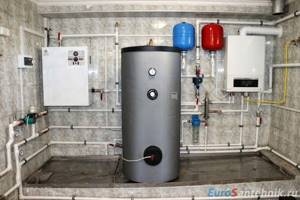
An electric boiler is installed on the left, a gas boiler on the right. Any type of heating in a private home differs in the way it “produces” heat. Each device uses different energy components during the heating process. Depending on the installation location, technical parameters of the room, building, and the connection of the power source itself, it is customary to use several types of fuel. The power supply of heating devices differs in the type of fuel and the method of supply.
This includes the following options:
- Gas;
- Solid fuel;
- Electric boiler.
The use of gas heating (propane-butane) involves the use of special equipment and additional systems (boilers, AGV), which ensures the correct dosage, safe supply and distribution of the fuel mixture during heat generation (combustion). Gas heating of a home is considered an effective heating method with a relatively low cost.
In the Russian Federation, gas heating is the cheapest way to provide heat in the house. The reason for this is the affordable price of gas and the relatively high heat capacity of gas (you can get 8-9 kW of heat from one cubic meter). Gas heating of a private house can be done with your own hands.
The solid fuel heating method includes the use of coal, firewood, and pressed briquettes as energy sources. In this case, special designs of boiler devices are used, adapted for such operating conditions. In areas where the supply of gas or electricity is difficult, this is the only alternative option for heating the home.
Electric home heating works by using network electricity. This type of heating is installed in places where current networks are present. Does not require additional power sources, quite economical and environmentally friendly method. Electric heating elements are used as heating elements.
By combining electricity tariffs, it is possible to make electric heating at home less expensive. A good option would be to use day-night tariffs, when electricity is cheaper at night. It is necessary to install an additional heat storage tank and heat it at night, and consume heat from it during the day.
Geothermal system
A non-standard approach to solving the problem of heating a country house. New technologies make it possible to use the energy potential of the earth by installing a geothermal heating system at home with your own hands. Up to 98 percent of solar energy is accumulated in the ground; heat is retained deep in the ground even in winter.
Special equipment helps deliver energy to homes for heating.
Geothermal heating in a simplified diagram looks like a heat pump and heat exchanger operating on the principle of an air conditioner. The heat pump is included in the internal and external circuits. Internal - a heating system made from ordinary pipes and radiators in the house. The external circuit (heat exchanger) is located underground. Coolants - water or liquid with antifreeze. The pump can operate in heater or air conditioner mode.
pros
- A geothermal heater can be installed in any location.
- The system does not pose a danger to humans and the environment
- You can receive an unlimited amount of heat.
- Minimum operating costs.
- You get geothermal heat for free, but you will have to pay for the operation of a pump running from the electrical network - a kilowatt of electricity provides 3-5 kW of heat.
Minuses
- High price of equipment and installation. The heating system will pay for itself in 7-8 years.
- Constructing a geothermal installation on your own is problematic, since the structure is located at a depth of about 100 meters and requires special equipment.
- Horizontal structures lie below the soil freezing level, but the collector occupies large areas. For example, to heat a house of 200 square meters. m. requires the use of heat from 500 sq. m of soil, not shaded by trees and other buildings.
What heating systems are used according to wiring methods
In private homes, water heating network pipelines are carried out in the following options:
- Vertical system with bottom wiring. This option involves laying pipes through the basement or, at a minimum, in a concrete floor screed.
- Vertical system with top wiring. The hot water supply line is installed in the attic of the house or in the ceiling space of the interior.
- Using a one-pipe system. Connection diagrams. The main feature of a single-pipe heating circuit is the sequential connection of heating radiators to the hot water supply pipe. In this case, there is a difference in the thermal heating of the radiator batteries located at the beginning and end of the heating line. Therefore, single-pipe wiring is used to heat rooms with an area of no more than 40 m2. It is advisable to use a vertical single-pipe scheme in low-rise buildings.

- Two-pipe heating system. In this case, two pipes are simultaneously connected to each radiator: for supplying hot water and for returning cooled coolant. Pipelines are laid in parallel lines at a short distance from each other.
Note: Two-pipe wiring allows you to individually regulate the temperature in each room without compromising the rest of the rooms.
Radiant heating distribution
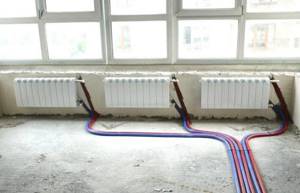
A radiant or collector heating network involves connecting each radiator directly to a heat source (collector). This connection diagram simplifies the replacement of a failed heating device without stopping the entire heating system.
Sometimes the collector is called the term “comb”, although this name is more often found in the description of the technological process of heating water in industrial enterprises and boiler houses. Due to its dimensions, the distribution manifold takes up a lot of space and to disguise it in private homes they use a small cabinet or a built-in niche with a door.
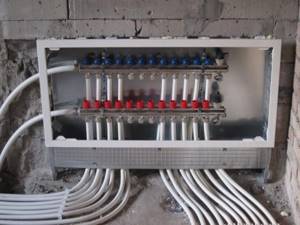
Scheme "Leningradka"
In private houses with a small area, a single-pipe pipeline layout is most often used. This model is easy to install and requires lower costs compared to other pipeline laying schemes.
However, if one of the radiators breaks down, you have to stop the heating line, drain the water from the entire wing of the line, and only then fix the breakdown.
To level out this drawback and not leave the house without heating in the winter cold, a single-pipe installation scheme called “Leningradka” is used. In this case, it is planned to install heating radiators of different capacities and use bypass bypasses. The pipe lining connects the inlet and outlet openings of the radiators in parallel, and if one of the heating elements fails, it can be easily disconnected and replaced.

Heating diagram for a one-story house with forced circulation of coolant
The water heating system of a private house operates in a cyclic mode to deliver hot water to the heating radiator and move the cooled coolant back to the boiler for subsequent heating. In modern conditions, for private homes, it is practiced to install a forced coolant circulation circuit.
The main advantages of this scheme:
- Minimum coolant volume.
- The diameter of the pipework is from 20 to 25 mm.
- Minimum pipe flow.
Main disadvantage
- Dependency of the system on electricity.
Ideally, a home heating network should have two circuits to heat residential premises and meet the needs for hot water.
Solar heating
An innovative technology that is becoming more and more popular in the world every day. If you are interested in this heating system, take the choice of equipment seriously, calculate the area, power, and find a suitable place for installation. A solar heating system will last more than 25 years, and with constant use will pay for itself in three years.
Solar panels in a country house are used to generate electricity. This type of heating is optimally used for electric heaters and heated floors.
pros
- No fuel costs.
- Environmental Safety.
- Easy to use and the ability to install solar heating for a private home with your own hands.
- Photocells and equipment are becoming affordable.
Minuses
- On cloudy days, little energy is produced.
- Expensive equipment and installation.
- The need for complex calculations and correct installation of elements.
- A number of installation conditions: roof at an angle of 30 degrees, absence of trees and buildings shading the roof, favorable climate.
Options for heating a private home
Autonomous heating systems used today for private houses combine ease of operation, high technology, efficiency and cost-effectiveness. The homeowner needs to decide which heating is best for the home, choosing heating boilers depending on their power and a number of other indicators. Depending on the type of coolant used, heating in a house is usually divided into the following types:
- electrical;
- air;
- steam;
- water;
- with open fire.
The choice of one or another type of heating boiler and the entire heating system is made primarily based on the area of the house, the characteristics of its operation and the available fuel.
In this video you will learn how to choose a radiator: The most popular today are gas boilers , which, thanks to automation, are completely safe to use. Fuel has a low cost, which reduces the homeowner's utility bills. If you have difficulties choosing the type of equipment, you can use the design documentation for the building, which will indicate which heating to choose for the house being built.
Steam heating
The old heating method has not lost its relevance against the backdrop of innovative systems. The coolant is steam, installation of the heating system is simple. The source is a steam boiler from which heat enters the pipes and radiators of the reduction-cooling equipment or steam turbine. Cooling, the steam turns into condensate and returns back.
Theoretically, you can build steam heating with your own hands, but boilers are not installed in private homes. The boiler is very large, the steam temperature exceeds 100°C, operation requires a professional approach. Traditionally, enterprises that use steam in their production process are heated this way, and its excess is used for heating.
Reliability of operation and temperature significantly depend on the quality of the boiler in this system, so it should be selected taking into account the area and structural features. Steam boilers operate on various fuels: liquid, solid, combined, natural gas.
pros
- Relative cheapness of the boiler.
- Fast heating of the room.
- Preservation of heat in the system.
Minuses
- Cumbersomeness and danger of steam boilers if used incorrectly.
- Heating heating devices to high temperatures.
- Inability to smoothly regulate room temperature.
- Filling the system with steam is accompanied by noise.
- Complex installation of the system.
Main types of heating
The difference between all existing systems depends on different criteria. Installation location, heating area, technical features of wiring and installation. In frequent cases, the type of design is influenced by the method of supplying energy and, of course, the total cost of the entire complex responsible for heating a private house.
Modern energy-saving technologies offer a wide selection of different heating systems using advanced developments. This article presents popular, common types of heating systems used in almost every home.
Stove heating
Just a century ago, this is how most houses, large and small, were heated. This is just a stove without any additional elements. One or more - depended on the size of the house and the capabilities of the owners. The huts usually had a large Russian stove, while the houses of the intelligentsia and nobility had more sophisticated Dutch or Swedish stoves.
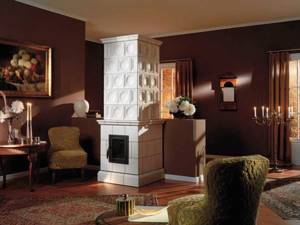
Dutch and Swedish women still bet
Stove heating is still used today, but mostly in dachas, as a temporary solution to raise the temperature in the room or as an alternative source of heat. You can also find stove heating in village houses, but this is already a rarity.
Stove heating is losing popularity, as it is cyclical: if it floods, it’s hot, if it burns out, it’s cold. It is very uncomfortable. The second serious disadvantage is the inability to regulate the temperature. The intensity of combustion can be changed within certain limits using views, but not radically: if wood burns, it releases a certain amount of heat. Its release can be “stretched” a little by limiting the air flow, but only a little.

An example of stove heating of a two-story house
The third drawback is the uneven distribution of heat. Those rooms into which the sides of the stove open are heated, and even then, the floor remains cold. In addition, even in heated rooms near the stove it is warm, at the far end of the room it can even be cold.
The fourth drawback is the need for constant maintenance - you can’t leave it for long. You have to constantly (or almost) be near the stove: keep it burning, clean it and re-light it. All these reasons have led to the fact that a stove in a private home usually appears as one of the possible sources of heat and is rarely the main one.
Water heating
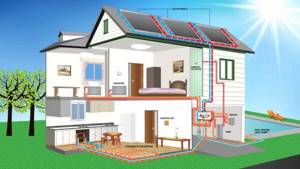
Among all the options, heating using liquid (water) as a coolant is considered the most popular. The advantages of the classic type of water heating have been revealed during many years of use. The technical characteristics of the system allow its operation in various conditions. Both in industrial buildings and in private sector buildings, apartments, offices. All this can be done with your own hands. Main advantages:
- Same temperature in all rooms.
- Length of service life.
- Possibility of using different materials of pipes and hardware (polypropylene, metal).
- Quiet operation.
- Fuel saving, easy maintenance.
The individual design elements of this option are an electric, multifunctional or gas boiler. Coal boilers are also used. With their help, water is heated and distributed through pipes (closed circulation) to the batteries. This is how the heat of the heated liquid is transferred to the premises. For ease of use, several subtypes are used. We'll talk about them below.
Air heating
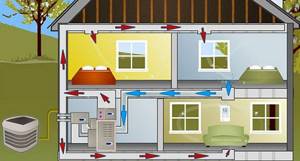
This type of heating was known and used in ancient times. Heated air was supplied into the room using an air duct system, thereby heating it. In its modern version, this is a common method of heating large areas. Until recently, it was used only in production workshops, sports facilities, and public spaces. But the development of modern technologies makes it possible to use the air method in private homes.
Heating and supply of air mass to the premises is carried out by air heaters. In large workshops, these are special installations that provide heating and constant circulation of air at a certain temperature. The local option involves the use of low-power air heating devices. Usually these are heat guns and fan heaters. The devices are quite mobile and use various construction methods (electric heaters, fuel burners, etc.) as the main heater.
The operation of air heating requires strict adherence to fire safety rules and basic hygiene requirements. The second provides for the presence of air purification filters, flow ventilation, air ducts, air curtains and other elements. As well as constant control over the air duct system as a whole.
Heating based on electricity
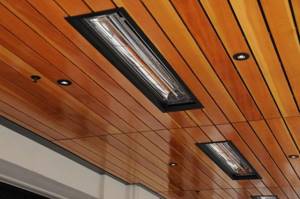
This type of heating works on the principle of converting electrical energy into heat. The main source of heat is an electric boiler or various heating devices (appliances). Boilers are used in water systems and are considered an environmentally friendly heating method. Individual devices have their own designs:
- Electric convectors.
- Air curtains.
- Oil radiators with heating elements.
- Infrared emitters (UVR), heated floors.
- Fan heaters, heat guns.
The use of different modifications depends on the installation location, heating area, and operating conditions. Electric convectors and oil radiators are well suited for heating apartments or private houses. This applies to UV devices and heated floors. All of the above methods are economical (subject to an affordable price for electricity) and do not require the use of several types of energy resources; only electricity can be used.
Electric heating
A well-known heating system using electrical appliances in which heat is generated by a current passing through a conductor. Often the electrical system is used as an auxiliary system, but in the absence of gas in the house it can also be the main one.
pros
- Ecological cleanliness.
- Easy installation.
- Heating appliances can be freely rearranged into any room with electrical wiring.
Minuses
- The need to pay for consumed electricity, the consumption of which will be large.
- When the power supply is turned off, the heating system does not work.
- When electrical appliances operate, oxygen is burned, so rooms need to be ventilated as often as possible.
In dachas and small houses, electric heating is often used, but heating a large house will require a lot of electricity. If you decide to choose this particular system as it is the simplest and does not require special knowledge for self-installation, take care of high-quality thermal insulation of the house.
Two-pipe heating: its advantages and disadvantages
Among the advantages, the following points should be noted:
- two-pipe wiring reduces heat loss to a minimum, since the main line is installed either in the basement or mounted in the floor;
- such a system can be launched in an unfinished house, even when only one floor is ready;
- the fact that the locking system of not only the supply, but also the return riser is located in the basement, allows you to save a lot of space in the house and facilitate repairs and maintenance of the heating structure;
- Residents have the opportunity to independently regulate the heat supply based on their needs - turn on heating in those rooms where it is needed;
- Heating with overhead piping may not be turned off when carrying out repair work on the upper floors.
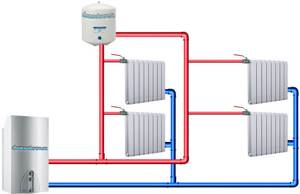
Disadvantages of two-pipe wiring:
- Arranging such a structure is quite an expensive pleasure. When installing a two-pipe system with your own hands, you will need twice as much materials;
- presence of low pressure in the supply pipe;
- the owner of the property will have to bleed air accumulated in the radiators much more often (about 2 times). An element such as a Mayevsky tap will simplify the removal of air plugs, but it costs a lot of money.
Regardless of which horizontal heating system layout is used, both single-pipe and two-pipe designs have their pros and cons. At the same time, overhead wiring significantly reduces utility costs, but its installation and operation have many difficulties.
One of the options for the heating system wiring diagram in the video:
Heating system "Leningradka"
This heating system is very popular due to its relatively simple installation, not too high price and the ability to regulate the air temperature in each individual room.
Single-pipe circuit with sequential installation of radiators on the circuit. Pipe routing can be horizontal or vertical. From the boiler, the coolant enters the network and returns to the heating boiler. You can install as many radiators in your house as needed to heat a particular room.
To optimize the operation of the system, it is advisable to equip the Leningradka with control and shut-off devices, as well as a circulation pump.
pros
- The ability to set the desired temperature in each room without completely disconnecting from the heating system.
- If there is a need to repair one heating device, you can turn it off, while the rest of the system continues to operate.
- Radiators heat up quickly and evenly.
- Small diameter pipes are used for installation, which saves money.
Minuses
- Installing a pump ensures the full functioning of the system, but requires financial expenses, incl. to pay for electricity.
- When there is a power outage, the system does not work because the pump stops.
Scheme
The Leningradka scheme for heating a private house with your own hands looks like this:
Heating a country house without gas
Before purchasing equipment and materials for an alternative space heating system, it is worth analyzing the available heat sources. Any system must initially be economically profitable; it is necessary to take into account the costs of installing and launching devices.
I advise you to consider such nuances as:
- Coolant cost.
- Service.
- Planned repairs.
Electric heating of a country house

Operating this type of heating is not difficult; significant costs can only be felt in country houses of medium and large area. Owners of small buildings will be able to use electric heaters quite effectively. The most common types of equipment of this type include the following:
- Thermal curtains.
- Heated floors.
- Heating element electric boilers.
- Oil heaters.
- Ceramic panels.
Some types of devices do not require piping; if the system does not have a boiler, they can simply be installed under window openings, providing only the supply of electricity. Do not forget about fire safety rules, for effective heating of 50 sq. m. with standard ceilings will require up to 8 kW of power, the network cannot be overloaded, otherwise you can get a lot of problems.
Stove solid fuel heating
Solid fuel boilers are not as bulky as old-style stoves; they will be quite “rough” to implement the plan, but the opportunity to make wiring around the house and replace the coolant in the heating system with a more productive one should also not be underestimated.
To equip rooms with radiators and install plastic pipes, you will need a special pump; without it, all attempts to heat the air as much as possible will be in vain. The fuel is often coal and firewood, which can easily be purchased in the required quantities; the only disadvantage of such units will be the abundant accumulation of garbage after the decay of combustion products; the task of throwing it away will seem burdensome after some time.
Diesel heating of a country house
The efficiency of such equipment is quite good, it reaches 85% depending on the brand of the unit and its condition. I noticed that for continuous operation of a diesel heating boiler, 0.9 liters per hour is enough; according to average calculations for the day, the number came out to be 0.7 l/hour. I can’t call the house too small, its area is 100 sq. m. m.
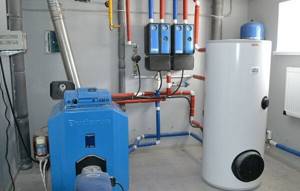
It is better to install this type of equipment in specially designated rooms; the place for the boiler room is thought out first. For maximum safety indicators, ceilings should not be less than 2.2 m, the area should not exceed 4 square meters. m, fresh ventilation should be installed in the room, and the fuel supply should not be increased by more than 800 liters.
Underfloor heating
A fairly good solution for country houses; the wiring can be of several types at the owner’s choice:
- Water.
- Electric.
- Infrared.
Each type of coolant has its own positive and negative sides; a system with liquid will require the installation of an additional boiler, while heating a country house with electricity will be easier to implement; heated floors can operate directly from the network, but repair work related to the cable will cause a lot of problems, after all, they are filled with screed.
Film and rod infrared heating is considered modern, but its cost will not be satisfactory for every owner, as will the maintenance of the equipment.
Heating a country house with a fireplace
This wood-burning heating of a country house will require the installation of air distribution, which will require quite a lot of both construction and finishing work. Fireplaces look noble, they give the atmosphere of the house more coziness and comfort, but I would not consider it as an element for generating coolant in a country house.
If the building is very small, then it will be possible to quickly warm it up, but when the area is impressive, such devices require an additional heat source and will not be an autonomous heating source for a country house.
Heat pump application
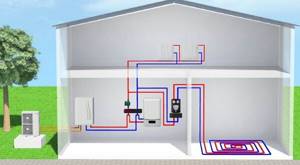
This type does not involve burning fuel; only the energy of the earth’s bowels is used. By installing this equipment, you can count on an endless resource, because in the process of heating rooms you only need to monitor the performance of the heat pump for heating and all important components of the system.
Geothermal condensation occurs due to special installations that have high efficiency rates, and energy consumption during operation will be minimal; this factor makes this type of heating system very popular.
Air convector heating
Compared to oil radiators, these units are able to quickly heat the air in the room thanks to the principle of convection. During operation, the device provides cyclic movement of cold and warm air mass.
The equipment is equipped with a heating element, which releases air through a special grille; some models are equipped with fans to forcefully accelerate the circulation of heat in houses with convectors; connection requires only a power supply.
Alternative fuel boilers
When considering all options for units for providing heating in country houses, I often pay attention to electrode equipment; it can be called an absolute novelty in this matter. It is impossible not to mention condensing boilers and induction models of devices.
But it is most practical to install a combined type of equipment in the house, in this case it will be possible to avoid all sorts of nuances in the operation of water heating in a country house.
Heating by stove
To keep the house warm, when designing indoor stove heating, it is most optimal for the stove to be located near the inner wall, if possible in the center of the house, heating the room. One stove can heat no more than two or three adjacent rooms. It is necessary to take into account that the thermal power from the stove surface exiting into each room compensates for the heat loss of this room. That is, the stove must be selected according to its heating capacity and design corresponding to the size of the room, taking into account heat losses from the heated room.
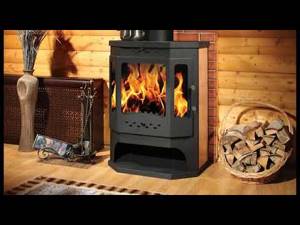
One solution for more efficient heating of several living rooms is heating from two stoves, grouped into one common heat unit. In this case, the combustion chambers will be located in different rooms, each of which is equipped with ventilation, a window and a door, and the chimneys are combined in the center of the room into one brick riser - a large heat accumulator. When choosing a coolant for stoves, you need to take into account the features and sanitary and hygienic requirements for each of the rooms in which these heating devices are located. Thus, to maintain a comfortable temperature in the room, one of the furnaces uses a long-term continuous combustion furnace mode. And the second oven operates periodically, during frosts, in accordance with the heat needs of the room.
Compared to stove heating, water heating using plate, metal radiators has an advantage, since it allows you to heat rooms remote from the heat generator. In practice, it often becomes necessary to additionally heat rooms remote from the stove. This can be achieved by installing a water heating device in the firebox of a Dutch oven and connecting it to the water heating system.
Stove heating is not often found in country houses today. Stoves still remain in rural houses, but even here they are used mainly for other purposes. But not so long ago, a stove was considered a multifunctional equipment:
- food was cooked on it;
- washed as if in a bathhouse;
- arranged as a sleeping place;
- it served to heat the house.
Now the stove is more of a decorative detail than a vital structure.
The organization of such heating has some difficulties, which were the reason for abandoning it.
- possibility of installation in houses with a maximum of three floors;
- the stove can heat no more than three rooms at the same time on the floor;
- The dimensions and design of the firebox must strictly correspond to the weight and type of fuel used.
- the need for constant presence near the furnace for maintenance.
Furnace design
A typical wood-burning stove has a very simple structure - it consists of a firebox, that is, a chamber with a door for loading, an ash pan with a blower and a chimney. That is, a subspecies of the potbelly stove. But it is precisely this design that does not allow heating many rooms at once. The solution is to arrange a water circuit, which consists of:
- fireboxes into which coal, firewood, etc. are loaded.
- fireboxes, for loading firewood, coal, etc.
- an ash pit into which the ash formed during combustion is deposited;
- chimney - serves to remove combustion products into the atmosphere;
- coil - a type of heat exchanger through which the medium circulates.
Example 10. Sectional structure of a home stove
The last element is the central link of the system, as it is responsible for the transfer of heat throughout the entire circuit.
The performance of the stove depends on the choice of firewood.
Main advantages:
- possibility of building a furnace yourself. This can be easily done using the drawings as a guide;
- low costs to maintain the system in operation due to the availability of fuel materials;
- you can prepare and chop firewood for future use yourself;
The result is practically free and quite efficient heating.
- The ash produced can be used as fertilizer for plants in the vegetable garden and garden.
- the stove can also serve as a fireplace;
- a live fire in the room creates a special, warm atmosphere in the room;
But there are also disadvantages:
- the need for regular ash removal;
- organizing a place to store a large amount of firewood;
- low utilization rate - only 80%. Factory-made models have an efficiency of 90%.
- To maintain the system in working condition, it is necessary to constantly add firewood. These frequent approaches are the main disadvantage of this type of heating.
- when servicing large rooms, the stove itself requires a lot of space and a massive thick-walled structure, which will take a long time to heat up;
- A design with thick walls must first heat them, and then the air in the room;
- significant heat loss through the chimney;
Today, homeowners most often design fireplaces built into the wall, in which a large percentage of the heat from the fire enters the room.
I hope the article has given you the opportunity to form an opinion about the types of heating, and you will be able to decide which system to install at home. A lot depends on the region where you live: perhaps you live in a warm climate zone, and you will not need heating even in winter.
Finally, about the scope of application
To avoid problems during operation, use single-pipe heating networks in suitable conditions:
- “Leningradka” works well in one-story dachas and small houses with an area of up to 150 m². If the quadrature does not exceed 70 m², one common ring for all batteries is sufficient, otherwise the system is divided into 2 circuits or a pipeline of a larger cross-section is laid.
- In a 2-story building, you can assemble an open-type gravity single-pipe circuit or a closed version with bottom wiring - your choice. In case of power outages, it is preferable to organize gravity flow and place the circulation pump on the bypass.
- Gravity flow with an accelerating manifold, used in one-story buildings, is characterized by inertia. Radiators warm up slowly, the water cools down greatly due to the low flow rate, and the boiler operates in extreme mode. It is better not to use this circuit at all; it is outdated and will not work normally without a pump.
- Feel free to divide the Leningradka into 2-3 separate floor loops with the optimal number of batteries on each. Do not combine the radiators of all floors into a single circulation circuit - the last devices will remain cold.
- The single-pipe Leningrad system is a suitable option for installing autonomous heating for a 2-3-room apartment.
Experts who prove the indispensability of single-pipe heating systems often refer to Soviet-built multi-story buildings, saying that they have 20 radiators per riser. But they forget to mention the pressure and performance of pumps from a centralized network, which is unattainable in private homes. Do not listen to would-be specialists and use the best system options - two-pipe, collector or associated.
Electrical
Electric heating involves the use of infrared heaters, electric convectors or underfloor heating.

This option is less economical than gas heating, as the cost of electricity is high. It is best to use it only when other options are not available.
Advantages and disadvantages
Among the positive aspects of using such a heating system are:
- the ability to use an electric boiler to heat various liquids;
- low costs for purchasing an electric heating system;
- no need for operational maintenance;
- an environmentally friendly way to maintain the desired temperature in a room;
- the ability to simultaneously install hot water supply along with the heating system.
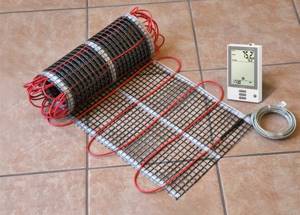
Electric heating also has disadvantages. Power consumption sometimes reaches 24 kW/hour. Such heating is subject to increased safety requirements. Power outages disrupt the system. Certain inconveniences are caused by the need to install a multiphase distributor, since many electrical networks cannot withstand high voltage. Good thermal insulation of the house is also necessary.
Consumption
Example No. 3. Calculation of electricity consumption. Let's assume that the area of the house is 100 m². To heat it, you will need a 10 kW unit (1 kW per 10 m² of area). The number of months in the heating season is 7.
- Monthly fuel consumption: 10 kW *24 hours* 30 days = 7200 kW.
- Average value: 7200 / 2 = 3600 kW.
- Annual fuel consumption: 3600 kW * 7 months = 25200 kW. Let's convert the resulting value into m³: 25200/10 = 2520 m³.
- Monetary value: 2520 * 4.97 = 12524, 40 rubles per year.
We install heating in a private house
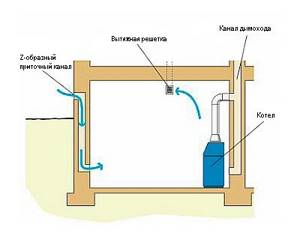
One of the options for a properly planned boiler room.
The heating system is installed in several stages. First of all, you need to arrange a room for the boiler. It must be well ventilated and treated with fireproof materials . The boiler itself is not mounted close to the wall, but with a slight indentation. You also need to retreat from the ceiling, floor and other walls. Hang the device so that it is easy to reach.
After installing the boiler, proceed to connecting the pump (if needed) or installing the manifold (if provided). Also secure all control and measuring instruments near the boiler. Only after the above actions should we proceed to the arrangement of main pipelines. Here you cannot do without a hammer drill, since to lay the line you will have to punch holes in the walls.
Important! The slope must be at least 5 mm per meter - it is very important to maintain the slope. The absence of this will negatively affect the operation of the entire system as a whole, so take this issue responsibly.

Schematic representation of the correct slope in the heating system. Water flows by gravity into the radiators and by gravity is sent back to the boiler.
Radiators are installed last. Before installation, you need to mark the wall, then drill holes where the brackets are installed. When marking, keep the following distances: from the floor to the bottom side of the battery - at least 10 cm, from the wall to the back wall - at least 2 cm, and from the window sill - at least 10 cm. It is advisable to install valves at all inputs and outputs of the batteries, which will simplify replacement or repair.
Only after all work has been completed can the system be checked. If you installed a gas boiler, be sure to call a gas service representative for a test run.
In fact, installing a heating system in a private home is not such a difficult task. It is enough to follow all the rules and work without haste. The only problem is the timing. If you don’t have too much time, then look at the prices for the work, figure out what you can do yourself and what is better to entrust to the masters. This way you will save time and money. Buy high-quality materials, then all the elements will last you much longer . Also install good radiators, they will have greater efficiency, which means fuel costs will be reduced.
Heating installation diagram with heated floors in a private house
In the previous sections, we looked at which boiler is best to use to organize heating in your home and how to install the pipes. Here we will look at another option - heated floors.

Like any other installation work, installing a heated floor involves a number of works. You need to start with design. Then, based on the completed project, materials and components are selected. This includes pipes, a manifold with a mixing unit, and insulation. Then the base is prepared where the pipes will be laid and the entire system is installed. When everything is ready, a test run is done. If everything works fine, then the base is poured, the initial start-up and warm-up are carried out.
According to the technical design, a heated floor is something like a layer cake, in which all the components are arranged in layers. The base is either soil or a concrete slab, on which a thin film is laid - polyethylene, which acts as waterproofing. Then a thermal insulation material is laid, for example, extruded polystyrene foam. Pipes are placed on top of the thermal insulation material and the whole thing is filled with cement.
How to do heating yourself - option for two wings
It was said earlier that the heating system has two options, one and two pipes. The most common and best for heat conservation is the two-pipe one. It is also represented by two types: dead-end and passing. In a dead-end circuit, the coolant in the supply pipe moves towards the flow of liquid in the return, i.e., simply put, the coolant moves in one direction. This scheme is called a Tichelman loop.
If the length of the pipes is large, then the entire wiring is divided into two parts or, as they say, into two wings. This scheme is especially popular in private homes and country houses.
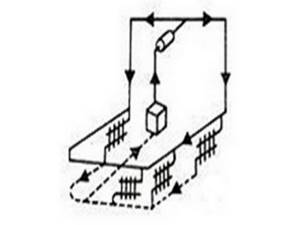
The length of both parts or wings must be made the same, and all radiators in this network are connected using valves. This will allow you to quickly and efficiently regulate the water supply.
Otherwise, the installation is similar to all others and does not require any special features.
Gas heating
Gas heating is now considered the most economical. With proper installation and calculations, an autonomous gas heating system not only maintains the optimal temperature in all rooms of the house by controlling the heat supply, but in this way it is also possible to achieve a huge reduction in money spent on energy resources. The main element of this heating system is a gas boiler, the choice of which depends on the heat loss of the house. The coolant, which fills the heating devices with heat, circulates through the pipeline. Heating devices can be called simple radiators and a system such as heated floors. To ensure regulation of the supply of coolant to the heating device, temperature regulators are built into the system. Using them in a heating system reduces costs by up to 30 percent. The big disadvantages of this type of heating include the complexity of the equipment and its installation.
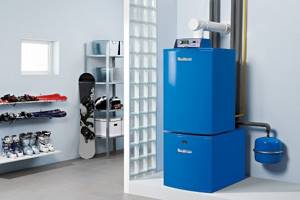
Advantages and disadvantages of gas heating boilers
The heating boiler is undoubtedly the heart of any residential building. In order to get an idea of the variety of offers, let's take a closer look at the main types of boilers, their advantages and disadvantages.
Types of gas boilers by installation methods
There are two types of devices - wall-mounted and floor-mounted.
The main difference between the two types is the metal used to make the primary heat exchanger. Most often, steel or cast iron heat exchangers are installed in such devices, and stainless steel or copper in wall-mounted ones. Copper and steel are very ductile materials that are light in weight and highly efficient; cast iron is very fragile and unstable to temperature changes, but resistant to corrosion.
Wall-mounted gas boilers have a number of advantages over floor-mounted ones. The main advantage is the power of a wall-mounted boiler, which ranges from approximately 12 to 40 kW, therefore the area that it can serve will be quite large.
1) Wall mounted version
Advantages:
- Compactness
- Light weight
- Acceptable price
Flaws:
- Not resistant to corrosion
- Sensitive to fuel quality
- Volatile
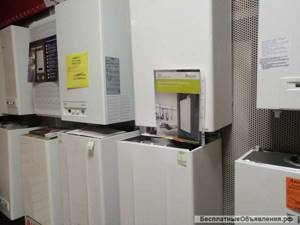
2) Floor-standing version
Advantages:
- Durable
- Has a wide range
- Corrosion resistant
- Can work without electricity
Flaws:
- Large weight and size
- Sensitive to temperature changes
- Compared to wall-mounted, it has the highest price

Types of gas boilers by functionality
All gas boilers can be divided into double-circuit and single-circuit.
1) Single-circuit boilers work only for heating the room. To obtain hot water, you will definitely need to connect a boiler to the boiler.
2) A double-circuit heating device is designed to both supply heat and heat water. If you do not particularly need hot water, then it is best to use a double-circuit flow type.
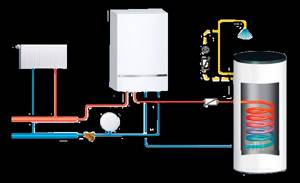
Example 1. Single-circuit gas boiler for heating
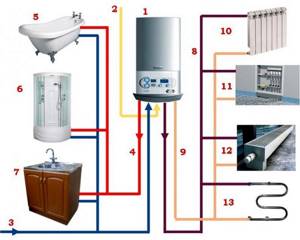
Example 2. Double-circuit gas boiler for heating
For more comfortable hot water supply, it is recommended to install equipment with a built-in boiler. This allows you to have a supply of hot water, even if the gas is turned off.
Types of gas boilers by method of gas removal
According to the method of removing exhaust gases, special attention should be paid to 2 types:
1) with natural draft - these boilers are usually connected to the chimney shaft
2) with a forced smoke exhaust system - when connected, a special coaxial chimney is discharged through the wall.
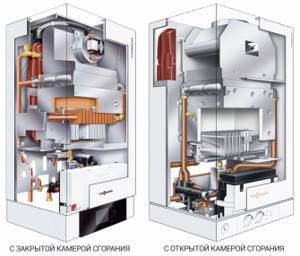
Buy a gas boiler in the Leroy Merlin retail chain
Stove heating
Stoves and fireplaces are used to heat homes. For cottages, these options are ineffective, since they do not ensure uniform distribution of heat throughout the rooms. It is better to choose them for use in dachas.
To decide which heating is more suitable for a private home, you need to choose the cheapest and most accessible fuel in your area. The price of artificial heating of a residential building directly depends on its consumption and cost. There is no universal option. Gas remains the most economical source of thermal energy. In areas where there are no main gas pipelines, you should pay attention to solid fuel and electrical resources.
What is required for installation
In a private house, do-it-yourself heating installation begins with drawing up a working diagram of the entire heating system with the exact linear dimensions of each section of the pipeline and the area of the premises. The drawing data is necessary to visualize the overall heating scheme and to calculate the required number of pipes.
In order to draw up an as-built diagram, you do not need to be a professional draftsman. It is enough to draw an arbitrary simple drawing, arrange the heating radiators on it and count the number of pipes for the combined circuit.
Based on the initial data and preliminary calculation of the required amount of thermal energy to heat the house, you can begin selecting materials for constructing a home autonomous system.
Selecting a Heat Source
The boiler is the main element of thermal energy generation. The main criterion for choosing a heat generator depends on the type of fuel as the source of its operation. Boiler power is calculated based on several factors:
- Volume of heated premises.
- Climatic features of the region.
- Thickness of external walls.
- Availability of thermal insulation of the main structural elements of the building.
- Availability of basement and attic space.
When choosing a heating boiler, it is important to pay attention to the adaptation of the selected model to domestic conditions and the availability of a quality certificate.
Pipes
A correctly selected type of heating pipe eliminates technical operational problems and guarantees a high degree of reliability of the heating line. More recently, steel metal pipes were used to lay heating pipelines. It was difficult to assemble such a heating network; individual pipes had to be welded together.
Currently, piping is best done from the following materials:
- polypropylene with internal reinforcement of aluminum or fiberglass;
- metal-plastic;
- cross-linked polyethylene;
- polyethylene with PE-RT additives;
- copper.
From the above list, the most popular are polypropylene pipes, which are characterized by strength, flexibility, resistance to temperature changes and corrosion. This material is easy to install and connect to heating radiators.
